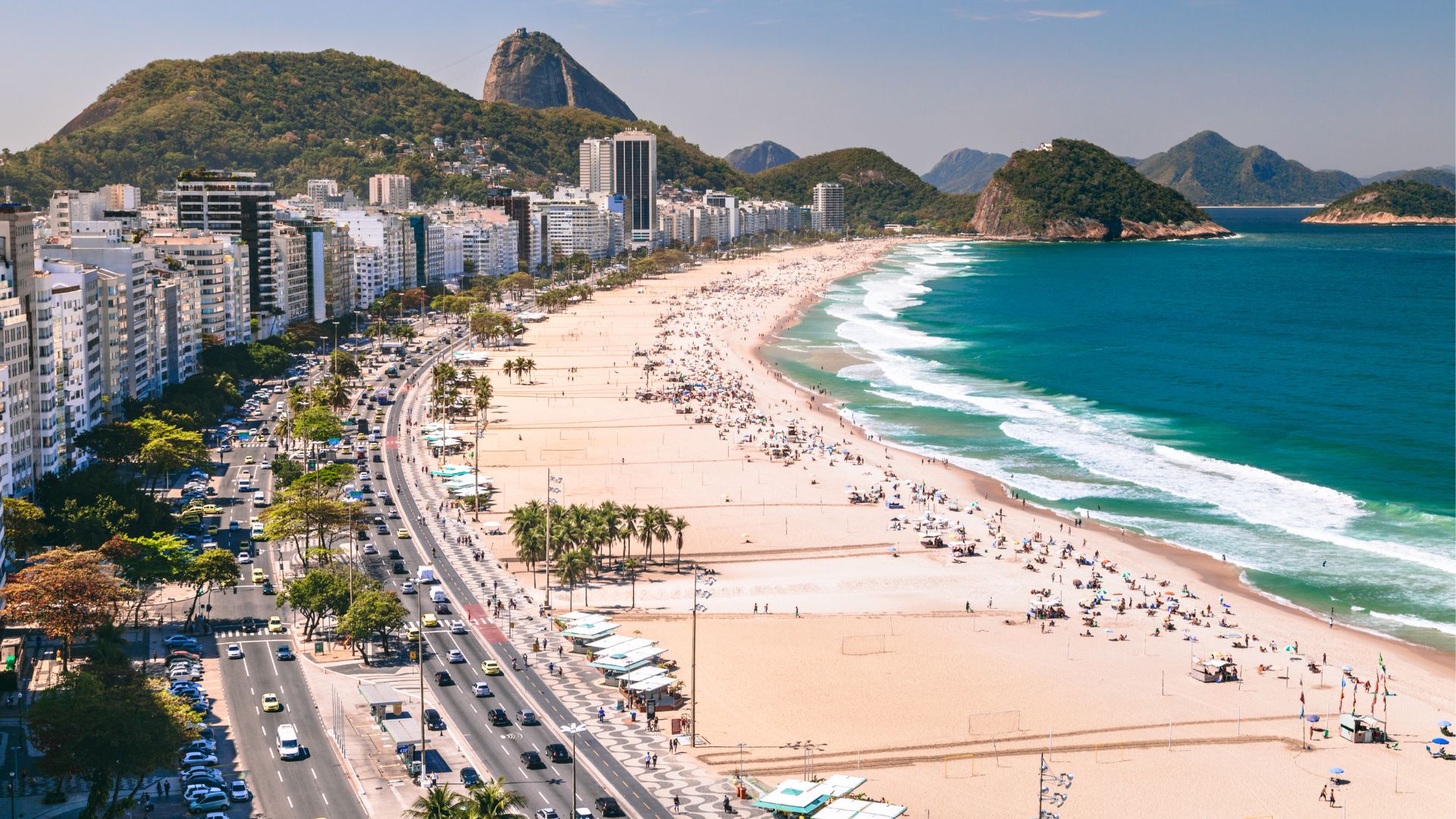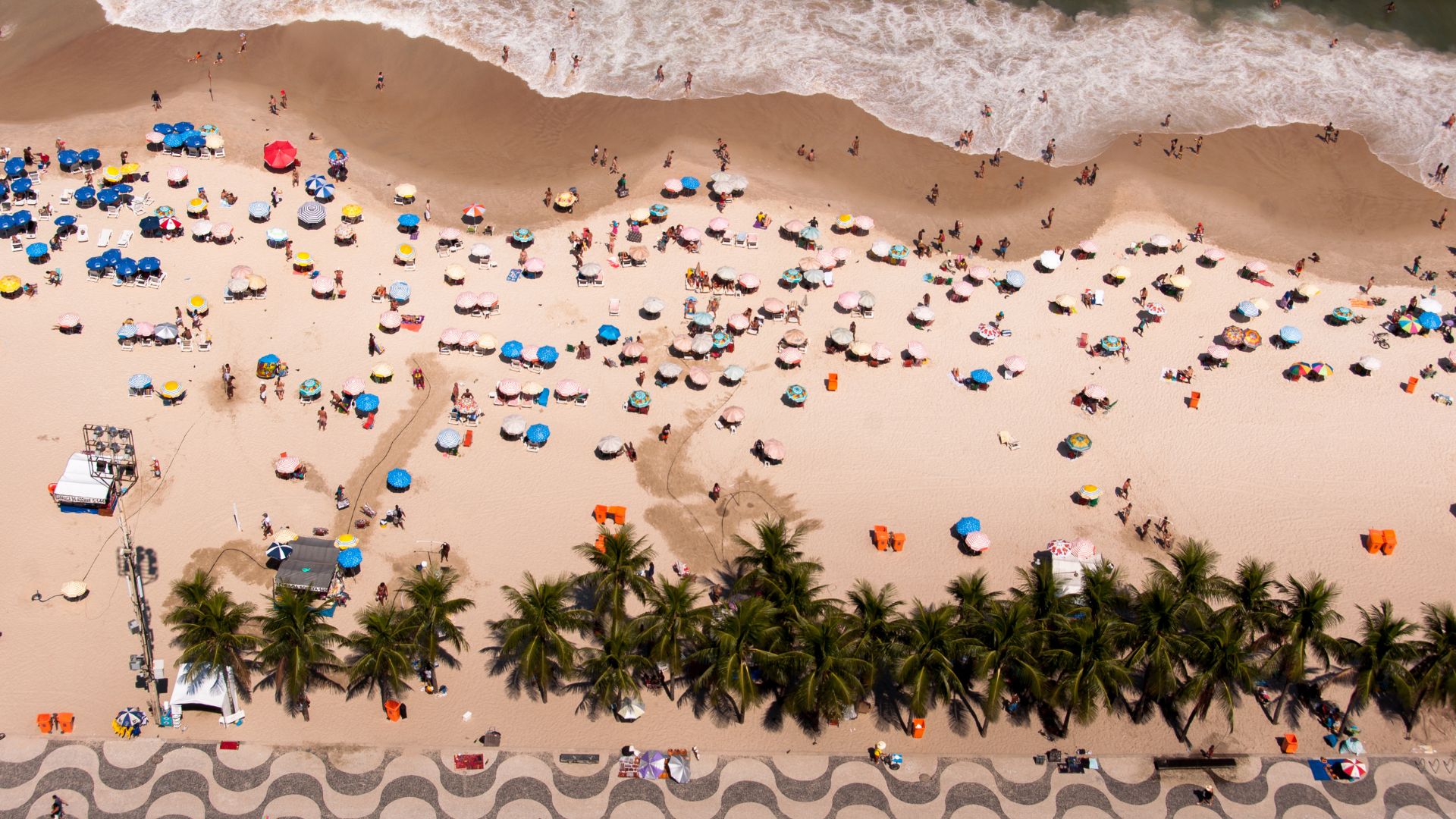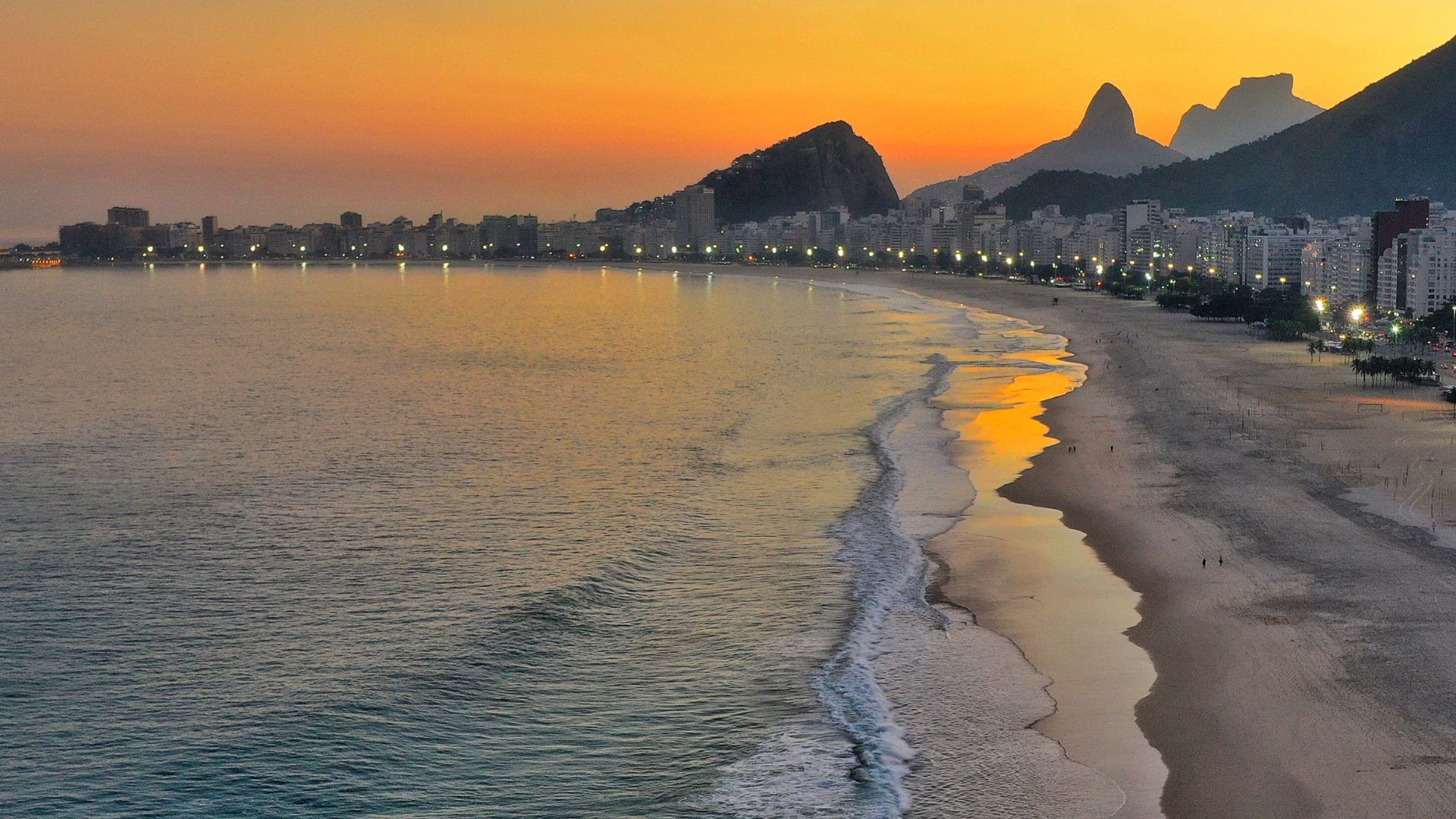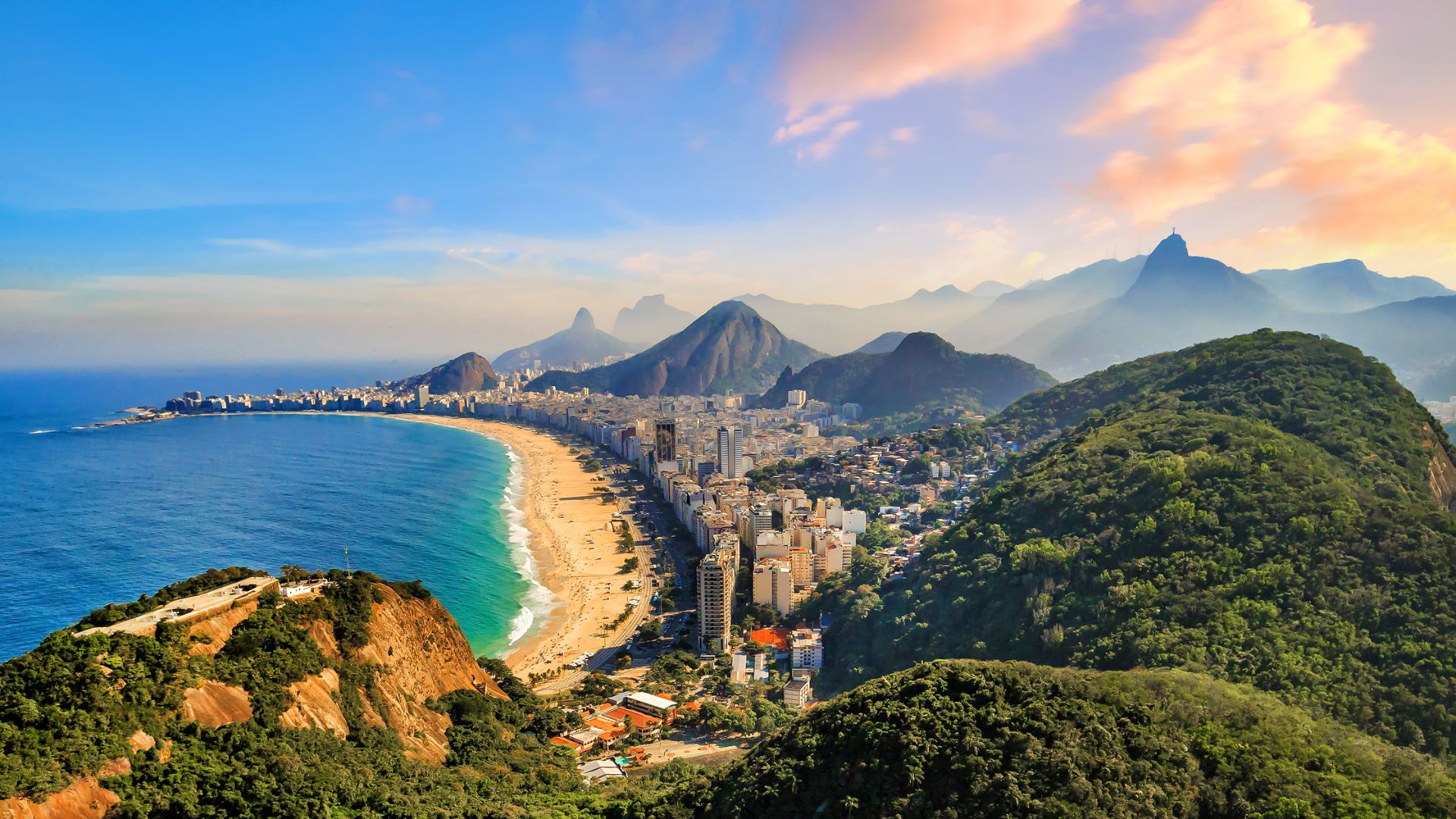Experience the vibrant heart of Rio at its most iconic golden shoreline
Stretching 4 kilometers along the coast, Copacabana Beach is more than just sand and sea. It is Rio de Janeiro’s lively outdoor hangout where locals and tourists come to relax, play, and enjoy the scene.

Highlights:
- Walk along the famous walkway, and watch locals play footvolley as the sun sets behind Sugarloaf Mountain
- Feel the energy of New Year’s Eve at Copacabana, when millions gather for live music and one of the biggest fireworks shows in the world
- Visit the old forts at both ends of the beach to learn about Brazil’s military history and enjoy wide views of the coast
Tickets & Prices
Copacabana Beach is free to enter, making it a great spot for any budget. Some services do cost extra. Beach chairs and umbrellas can be rented from vendors for a small fee, typically ranging from R$5 to R$10 per item for the day.
Beachside kiosks offer refreshments and snacks at varying prices, with local favorites like caipirinhas available for as little as R$10.
For those interested in visiting the historical Fort Copacabana at the south end of the beach, there is a modest entrance fee to access the Army Historical Museum housed within.
Opening Hours
Copacabana Beach is open all day and night, but swimming is safest during daylight hours when lifeguards are on duty. The beach gets busiest from 10 AM to 4 PM, especially in summer from December to March.
For a quieter visit, go early in the morning between 6 and 8 AM or later in the afternoon when the sun is less strong.
Fort Copacabana is open from 9 AM to 5 PM, Tuesday to Sunday. It is closed on Mondays for maintenance. Hours may change on holidays or during events, so it is best to check ahead before your visit.

What to See and Do
As soon as your feet touch the sand at Copacabana Beach, you become part of the energy that makes this one of the most famous beaches in the world. Here are the top things to enjoy at Copa.
Soak Up the Beach Culture
The heart of Copacabana is its beach life, buzzing from early morning until late at night. The beach is split into sections by lifeguard towers called postos, numbered from Posto 1 to Posto 6, and each one has its own feel.
Leme, near Postos 1 and 2 on the east side, is quieter and more relaxed, with a reggae vibe locals love. It is a great spot if you want to avoid the big crowds and just chill.
What stands out about Copa is how alive it stays, even when the weather turns cloudy. While nearby Ipanema might clear out, Copacabana keeps its energy no matter what.
Top tip: Rent a beach chair and umbrella from one of the vendors for as little as R$5-10 per item (much cheaper than at Ipanema). The vendors will set everything up for you and keep an eye on your spot if you decide to take a dip.
Try Beach Sports
Copacabana is more than a place to relax. It is a giant outdoor sports area. You will see volleyball nets all along the beach where locals play both regular volleyball and footvolley, a Brazilian mix of soccer and volleyball.
If you want to join in, you can rent gear from vendors or join a game of beach soccer. There are also outdoor gyms where people work out all day long.
Even if you are not playing, watching footvolley is fun. The players do amazing moves using only their feet, chest, or head to hit the ball.
Walk the Iconic Walkway
The black and white wave-patterned sidewalk along Copacabana is almost as famous as the beach. It was designed by Brazilian landscape artist Roberto Burle Marx and has become one of the most well-known sights in Rio.
The 4 kilometer path is great for walking, jogging, or biking, with lanes for each. In the morning, locals come out to exercise before it gets too hot. In the evening, it turns into a lively space with families, friends, and street performers.
You will also find kiosks selling cold drinks and local snacks. It is a great place to stop, relax, and watch the world go by.
Explore the Historic Fortresses
At both ends of Copacabana Beach, you will find old forts that share Brazil’s military history and offer some of the best views in Rio.
On the south end, Fort Copacabana was built in 1914 and now holds the Army History Museum. You can explore exhibits and enjoy wide views of the beach. There is also a cafe from the famous Confeitaria Colombo where you can have pastries by the sea.
On the north end near Leme, Fort Duque de Caxias dates back to 1779. It is quieter than the other fort but has great views and a calm vibe, perfect for a peaceful visit.
Enjoy the Beach Gastronomy
One of the best parts of Copacabana is the steady stream of food and drink vendors walking along the sand. You will never go hungry or thirsty here.
Try a cold mate leão with lemon, a refreshing tea that locals drink to stay cool. For a snack, go for queijo coalho—grilled cheese on a stick with oregano, cooked right in front of you on small grills, or the Rio famous *Biscoito Globo—*a traditional, light and crunchy beach snack.
Beach kiosks also serve cold coconut water, strong caipirinhas, and simple meals like açai bowls with granola, fried fish with lime, or warm *pão de queijo—*a cheesy bread snack.
Top tip: Always ask the price before buying from vendors to avoid surprises.
Catch the Sunset at Arpoador
Just between Copacabana and Ipanema, Arpoador is a rocky spot that gives you one of the best sunset views in Rio. It is a short walk from the end of Copacabana and worth the visit to join locals as they clap when the sun sets over the ocean.
The big rocks make a perfect place to sit and watch surfers in the water below. From here, you get amazing views of both beaches, Sugarloaf Mountain, and the Two Brothers peaks in the distance.
Experience Special Events
If you visit Rio during special events, Copacabana Beach turns into one of the biggest open-air stages in the world.
New Year’s Eve, known as Réveillon, is the most famous. Over 2 million people dressed in white gather each year on the sand to watch fireworks and enjoy live music.
During the year, the beach also hosts concerts, sports events, and cultural shows, making it more than just a place to relax in the sun.

Directions
Copacabana Beach is easy to reach from many parts of Rio, with the metro being the fastest and most reliable option. Three Line 1 stations serve the area: Cardeal Arcoverde (near Posto 6 and Fort Copacabana), Siqueira Campos (central beach access), and Cantagalo (close to Ipanema).
Buses are another good option, running often along Avenida Atlantica and Avenida Nossa Senhora de Copacabana. Look for buses with “Copacabana” on the sign—popular routes include 583, 584, and Linha 2. A standard fare is about 4.05 reais. If you prefer more comfort, Uber is widely available and usually safer and cheaper than regular taxis.
If you’re staying in Ipanema or Leblon, you can also walk to Copacabana along the beachfront path, which takes about 30 minutes and offers great ocean views.
Nearby Places
Ipanema Beach: Ipanema Beach is just a short walk from Copacabana and offers a more laid-back and stylish vibe. With great views of the mountains and a younger, more local crowd, it is the perfect spot to compare the energy and feel of Rio’s top beaches.
Sugarloaf Mountain (Pão de Açúcar): Sugarloaf Mountain, or Pão de Açúcar, is one of Rio’s most famous landmarks. You can take a cable car to the top for views over the city, ocean, and mountains.
Arpoador: Arpoador sits between Copacabana and Ipanema and is known for its beautiful sunsets. People gather here every evening to watch the sun go down over the water and often clap as it sets.
Confeitaria Colombo: Confeitaria Colombo is located within Fort Copacabana, this historic café offers a delightful selection of pastries and Brazilian treats. Patrons can enjoy their meals with panoramic views of the ocean, making it a perfect spot for breakfast or a mid-day snack .
Copacabana Palace Hotel: Copacabana Palace Hotel is a symbol of Rio’s glamour, open since 1923. This grand hotel is known for its classic white facade and long history of hosting stars and royalty.
Did you know that: (5 Interesting Facts!)
- The black and white wave-patterned sidewalk along Copacabana was designed by Brazilian landscape artist Roberto Burle Marx. It was inspired by the traditional Portuguese pavement seen in Lisbon.
- Copacabana’s New Year’s Eve party, called Réveillon, is one of the biggest in the world. Over 2 million people dressed in white gather to watch fireworks and make offerings to Yemanja, the Afro-Brazilian sea goddess.
- In the past, Copacabana was a far-off area only reached by tram in 1892. That tramline helped turn it into the famous beach neighborhood it is today.
- The beach became even more well-known after Barry Manilow’s 1978 hit song “Copacabana.” The song is actually about a nightclub in New York named after the beach—not the beach itself.
- The name Copacabana comes from a Bolivian town on Lake Titicaca, famous for the shrine of the Virgin of Copacabana, a patron saint of Bolivia. The name later spread to Brazil via colonial religious influence.

History
- 1750s: The area now known as Copacabana was largely uninhabited, serving primarily as fishing grounds for local communities.
- 1892: The first tram line connecting Copacabana to the rest of Rio de Janeiro was established, making the area accessible and sparking development.
- 1914: Fort Copacabana was established at the southern end of the beach, serving as a military fortification to protect the harbor.
- 1923: The luxurious Copacabana Palace Hotel opened its doors, quickly becoming a symbol of elegance and attracting international celebrities to the area.
- 1930s-1940s: Copacabana emerged as Rio’s fashionable neighborhood, with art deco buildings rising along the coastline.
- 1970: The walkway’s iconic black and white wave pattern was designed by landscape architect Roberto Burle Marx, becoming one of Rio’s most recognizable features.
- 1992: The United Nations Earth Summit in Rio brought international attention to Copacabana when it hosted major events related to the conference.
- 1994: Copacabana hosted its first major international concert when the Rolling Stones performed to an audience of 1.5 million people.
- 2007: The beach volleyball world championship was held at Copacabana, establishing it as a premier venue for international sporting events.
- 2016: Copacabana Beach served as the venue for beach volleyball competitions during the Summer Olympics hosted in Rio de Janeiro.
FAQ
Is Copacabana Beach safe for tourists?
Copacabana Beach is generally safe during daylight hours, especially in populated areas. Always stay vigilant, avoid displaying valuables, and stick to well-lit, crowded sections at night.
What’s the best time to visit Copacabana Beach?
The ideal time to visit is from April to June or September to October when the weather is pleasant and crowds are smaller.
Can I swim at Copacabana Beach?
Swimming is possible, but exercise caution as currents can be strong. Always swim in designated areas where lifeguards (known as “bombeiros“) are present, typically between 7 AM and 6 PM. Pay attention to the colored flags indicating water conditions.
What should I bring to Copacabana Beach?
Bring sunscreen (minimum SPF 30), water, a hat, beach towel, and cash for vendors. Consider wearing swimwear under clothes and leaving valuables at your hotel.
How does Copacabana compare to Ipanema Beach?
Copacabana is more touristy, bustling, and affordable than neighboring Ipanema. It offers more beachside amenities and activities, while Ipanema attracts a younger, more local crowd with a slightly upscale feel.